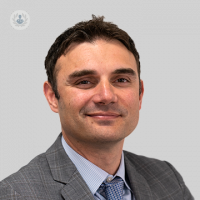Can lower back pain be treated by radiofrequency denervation?
Written by:Radiofrequency denervation is a non-invasive procedure for patients who live with severe lower back pain and who have difficulty in walking or moving their legs. Here, pain mangement specialist, Dr Giancarlo Camilleri, discusses radiofrequency denervation as a treatment option for chronic pain sufferers, how it works and whether the procedure itself is painful.

What is radiofrequency denervation?
Throughout the entire spine there are joints called facet joints. These joints are located in pairs along the posterior (back) of the spinal column but are not very close to the actual spinal cord. These joints are small and somewhat fragile and are prone to injury in certain types of traumatic, inflammatory or degenerative conditions.
Each facet joint is supplied by a sensory nerve called the medial branch nerve. A good analogy is to consider these nerves like little telephone wires that carry pain signals from your facet joints.
These medial branch nerves to the facet joints can be destroyed by the use of a special technique called radiofrequency denervation, thereby rendering the facet joint ‘painless’.
In this technique, a special needle is placed under X-ray guidance. When the needle is in the correct position, it is attached to the radiofrequency generator. The generator gives your doctor the ability to verify the position of the needles in relation to the nerves in the area. When your doctor is sure the location is appropriate and safe, the radiofrequency generator will be used to heat the tissue at the end of the needle. This will destroy the nerve that supplies the facet joint.
If necessary, this procedure will be repeated at several levels as determined by where your pain is arising from.
Is the procedure painful?
No incisions are required for radiofrequency denervation procedures. The entire procedure is conducted using specialised needles which allows the tip of the needle to be heated. In the majority of cases, the procedure can be conducted using just local anaesthetic to the skin and soft tissues.
Some people, however, may find the local anaesthetic application minimally uncomfortable. Sedation and pain-relieving medication can be administered intravenously for the denervation if you are worried about feeling any pain. It is important to point out that you will not feel the heating effect of the needles.
How many times would I need the procedure?
As the medial branch nerves that supply the facet joints lie outside of the spinal cord, the nerve will regenerate with time. On average it takes about 12-18 months for the nerves to ‘regrow.’
This means that pain signals will once again be able to be transmitted from any damaged facet joints. If you notice your back pain once again around the 12-18 month period, it is possible to simply have the radiofrequency denervation procedure repeated.
It is important to stress that whilst the medial branch nerves do regenerate, not everyone will feel their back pain come back again. Factors that influence whether your pain comes back include the original underlying cause and whether an individual has managed to make progress with spinal reconditioning and physiotherapy during the time they were pain-free.
What’s the success rate?
It is very important to highlight that radiofrequency denervation is not a cure for spinal pain due to the eventual regeneration of the medial branch nerves.
The success of the procedure usually depends on the accuracy of the diagnosis, individual variation in the spinal anatomy and to a degree the type of technique used.
Research studies generally suggest 58% of patients obtaining complete relief of low back pain and 70% of patients achieving greater than 50% relief of their low back pain.
For neck pain, the outcomes are generally better because of the reduced variation in anatomy with 74% of patients achieving 80% relief of their neck pain.
To schedule in an appointment with Dr Giancarlo Camilleri, head on over to his Top Doctors profile today.


